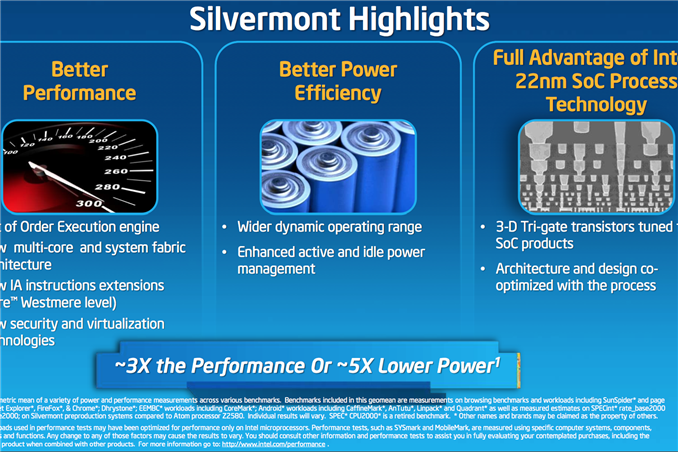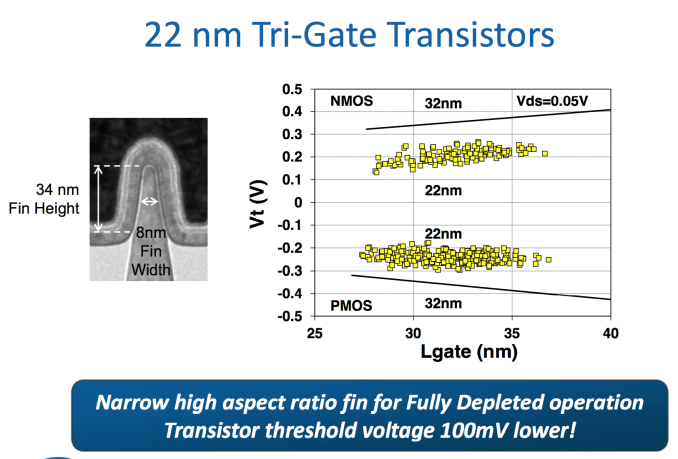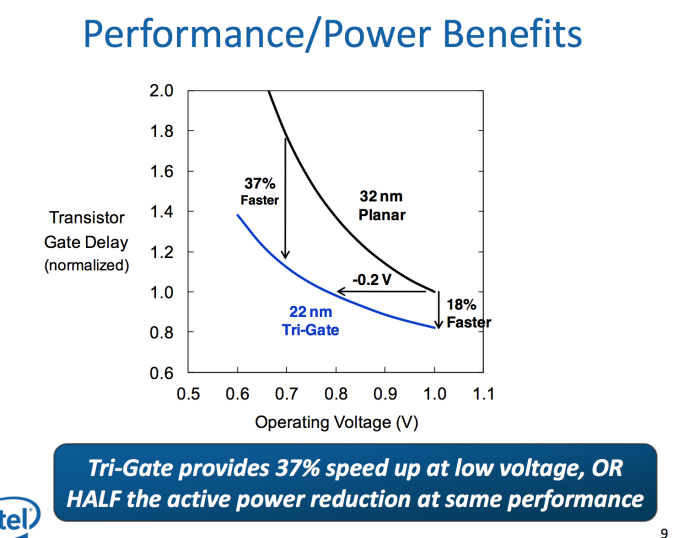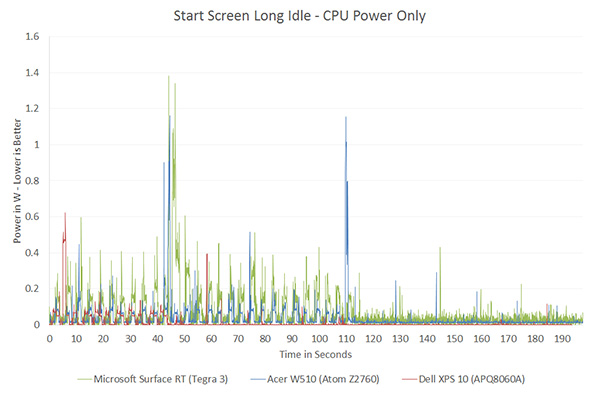Intel’s Silvermont Architecture Revealed: Getting Serious About Mobile
by Anand Lal Shimpi on May 6, 2013 1:00 PM EST- Posted in
- CPUs
- Intel
- Silvermont
- SoCs

The most frustrating part about covering Intel’s journey into mobile over the past five years is just how long it’s taken to get here. The CPU cores used in Medfield, Clover Trail and Clover Trail+ are very similar to what Intel had with the first Atom in 2008. Obviously we’re dealing with higher levels of integration and tweaks for further power consumption, but the architecture and much of the core remains unchanged. Just consider what that means. A single Bonnell core, designed in 2004, released in 2008, is already faster than ARM’s Cortex A9. Intel had this architecture for five years now and from the market’s perspective, did absolutely nothing with it. You could argue that the part wasn’t really ready until Intel had its 32nm process, so perhaps we’ve only wasted 3 years (Intel debuted its 32nm process in 2010). It’s beyond frustrating to think about just how competitive Intel would have been had it aggressively pursued this market.
Today Intel is in a different position. After acquisitions, new hires and some significant internal organizational changes, Intel seems to finally have the foundation to iterate and innovate in mobile. Although Bonnell (the first Atom core) was the beginning of Intel’s journey into mobile, it’s Silvermont - Intel’s first new Atom microarchitecture since 2008 - that finally puts Intel on the right course.
Although Silvermont can find its way into everything from cars to servers, the architecture is primarily optimized for use in smartphones and then in tablets, in that order. This is a significant departure from the previous Bonnell core that was first designed to serve the now defunct Mobile Internet Devices category that Intel put so much faith in back in the early to mid 2000s. As Intel’s first Atom architecture designed for mobile, expectations are high for Silvermont. While we’ll have to wait until the end of the year to see Silvermont in tablets (and early next year for phones), the good news for Intel is that Silvermont seems competitive right out of the gate. The even better news is that Silvermont will only be with us for a year before it gets its first update: Airmont.
 Intel made this announcement last year, but Silvermont is the beginning of Intel’s tick-tock cadence for Atom. Intel plans on revving Atom yearly for at least the next three years. Silvermont introduces a new architecture, while Airmont will take that architecture and bring it down to 14nm in 2014/2015. One year later, we’ll see another brand new architecture take the stage also on 14nm. This is a shift that Intel needed to implement years ago, but it’s still not too late.
Intel made this announcement last year, but Silvermont is the beginning of Intel’s tick-tock cadence for Atom. Intel plans on revving Atom yearly for at least the next three years. Silvermont introduces a new architecture, while Airmont will take that architecture and bring it down to 14nm in 2014/2015. One year later, we’ll see another brand new architecture take the stage also on 14nm. This is a shift that Intel needed to implement years ago, but it’s still not too late.
Before we get into an architectural analysis of Silvermont, it’s important to get some codenames in order. Bonnell was the name of the original 45nm Atom core, it was later shrunk to 32nm and called Saltwell when it arrived in smartphones and tablets last year. Silvermont is the name of the CPU core alone, but when it shows up in tablets later this year it will do so as a part of the Baytrail SoC and a part of the Merrifield SoC next year in smartphones.
22nm
To really understand the Silvermont story, you need to first understand Intel’s 22nm SoC process. Two years ago Intel announced its 22nm tri-gate 3D transistors, which would eventually ship a year later in Intel’s Ivy Bridge processors. That process wasn’t suited for ultra mobile. It was optimized for the sort of high performance silicon that was deployed on it, but not the ultra compact, very affordable, low power silicon necessary in smartphones and tablets. A derivative of that process would be needed for mobile. Intel now makes two versions of all of its processes, one optimized for its high performance CPUs and one for low power SoCs. P1270 was the 22nm CPU process, and P1271 is the low power SoC version. Silvermont uses P1271. The high level characteristics are the same however. Intel’s 22nm process moves to tri-gate non-planar transistors that can significantly increase transistor performance and/or decrease power.
This part is huge. The move to 22nm 3D transistors lets Intel drop threshold voltage by approximately 100mV at the same leakage level. Remember that power scales with the square of voltage, so a 100mV savings depending on what voltage you’re talking about can be very huge. Intel’s numbers put the power savings at anywhere from 25 - 35% at threshold voltage. The gains don’t stop there either. At 1V, Intel’s 22nm process gives it an 18% improvement in transistor performance or at the same performance Intel can run the transistors at 0.8V - a 20% power savings. The benefits are even more pronounced at lower voltages: 37% faster performance at 0.7V or less than half the active power at the same performance.
The end result here is Intel can scale frequency and/or add more active logic without drawing any more power than it did at 32nm. This helps at the top end with performance, but the vast majority of the time mobile devices are operating at very lower performance and power levels. Where performance doesn’t matter as much, Intel’s 22nm process gives it an insane advantage.
If we look back at our first x86 vs. ARM performance data we get a good indication of where Intel’s 32nm process had issues and where we should see tangible improvements with the move to 22nm:
Qualcomm’s 28nm Krait 200 was actually able to get down to lower power levels than Intel could at 32nm. Without having specific data I can’t say for certain, but it’s extremely likely that with Silvermont Intel will be able to drive down to far lower power levels than anything we’ve ever measured.
Understanding what Intel’s 22nm process gives it is really key to understanding Silvermont.













174 Comments
View All Comments
Jumangi - Monday, May 6, 2013 - link
Let me know when Intel has something of actual substance to show and not just bunch of marketing/hype focused Powerpoint slides. ARM continues to delivers solid performance gains year after year with low power usage...Intel says yea we'll will get around to updating our 5 year old design...eventually we promise...yawn...Krysto - Monday, May 6, 2013 - link
Great point. Intel keeps promising how awesome they will be when they launch their new "mobile" chip, and at always it's ALWAYS disappointing, because in the mean time ARM chips keep shipping on their merry way, and keep improving. Fast.A5 - Monday, May 6, 2013 - link
Eh. A15 wasn't exactly a home run. The performance is good for what it is, but they overshot their TDP targets big time.saurabhr8here - Monday, May 6, 2013 - link
A15 wasn't a home run because it has been developed on an early bleeding edge technology. As the process technology matures and the design is optimized for the process, the power/performance numbers will improve.DanNeely - Tuesday, May 7, 2013 - link
A15's problem isn't overshooting TDP targets; it's that it was originally designed for use in entry level NASes and other similar level embedded systems/micro servers. A few extra watts for better CPU performance isn't a big problem there.xTRICKYxx - Tuesday, May 7, 2013 - link
Exactly. A15 was not initially designed for smartphones.Wilco1 - Tuesday, May 7, 2013 - link
That's not correct, ARM has said from the early announcements that it would go into mobiles at lower frequencies and core counts. Of course both core counts and frequencies turned out to be higher than originally expected, so power consumption is higher too. The Exynos 5250 appears to be released quickly in order to be first to market. The Octa core is far more tuned and will do better. NVidia has stated Tegra 4 uses 40% less power than Tegra 3 at equivalent performance levels.Krysto - Monday, May 6, 2013 - link
Let's do a recap. Performance is as high as Cortex A15...a chip launched in 2012.GPU performance is where iPad 4 was...in 2012.
They are doing their benchmarks against last-gen ARM chips...okay.
Intel Silvermont is expected late 2013/early 2014.
Yeah...it's obviously so competitive! NOT.
By the time Intel Silvermont arrives in smartphones (Merrifield), we will see 20nm ARMv8 chips in smartphones, already shipping. Good luck, Intel, another hit and a miss.
As for what you said that Silvermont is conservative because they don't want to basically cannibalize Haswell - that's EXACTLY Intel's biggest problem right now. Their conflict of interest between the low-end, unprofitable Atom division, with the high-end very profitable Core division.
This is exactly what killed their Xscale division, too. And it's what will kill Intel in the end. Because Intel will have to make Atom compete *whether they want to or not*. ARM chips are going to go higher and higher performance and become "good enough" for most everything. What is Intel going to do then? They'll have to keep up, which will slowly eliminate their *profitable* Core chips from the market. And what then? Survive on $20 chips with a dozen competitors? This is going to be very interesting for Intel in the next few years - and not in a good way, especially with a brand new CEO.
Kjella - Monday, May 6, 2013 - link
It's been four months of 2013, how many quad-core ARM processors have launched since 2012? They're comparing against what is out now (if they were able to compare against unreleased ARM processors there'd be something very wrong) and beating them, not sure where your reading comprehension failed there. Looks to me like they're ready for a clash of the titans around year's end. Also 1-5W chips don't compete much with 15-85W Haswells no matter what, AMD is dying fast and people need their x86 computers so whatever. Reminds me of all the posts that say Windows is sooooooo dead.xTRICKYxx - Tuesday, May 7, 2013 - link
AMD is making a lot of money right now.